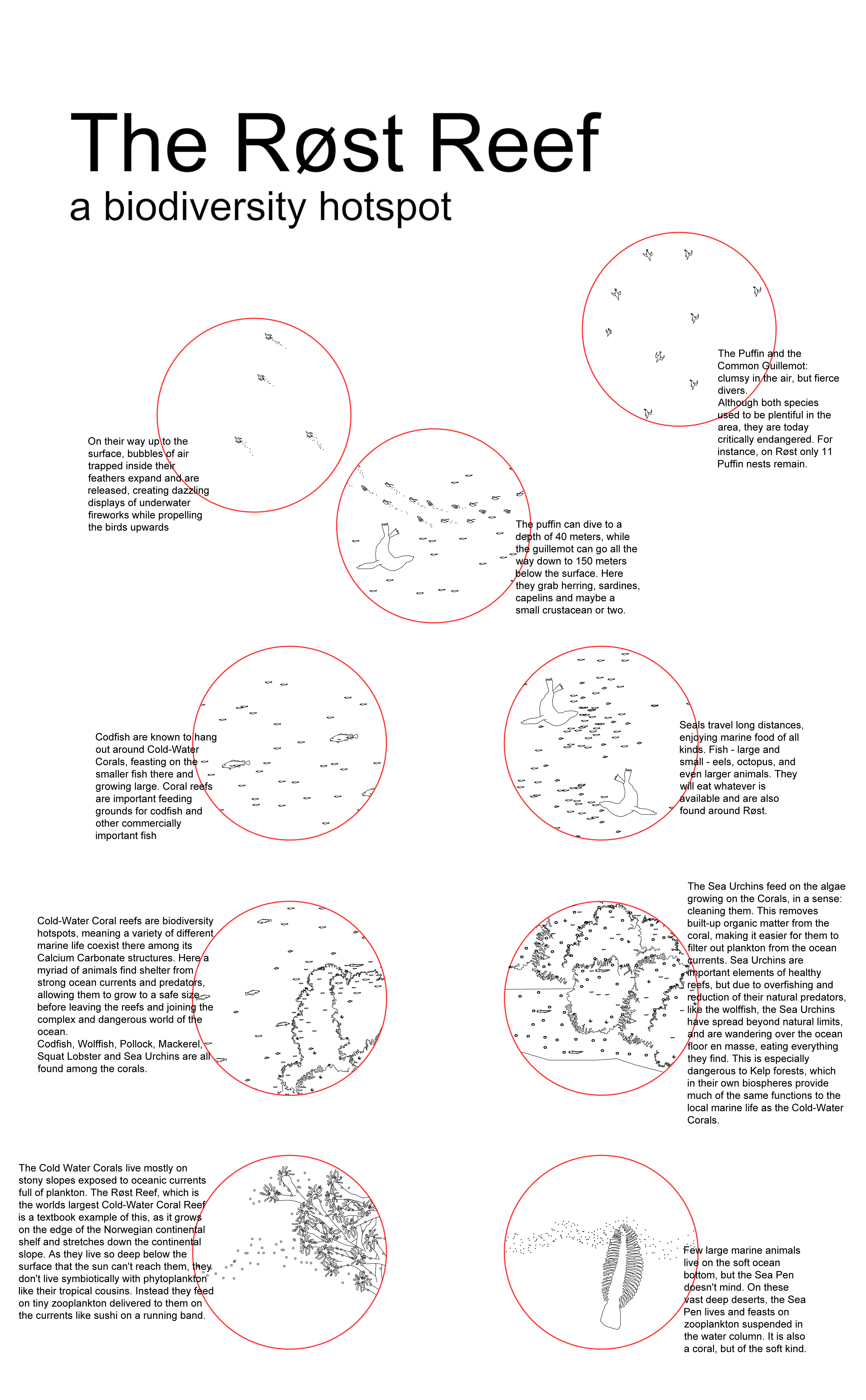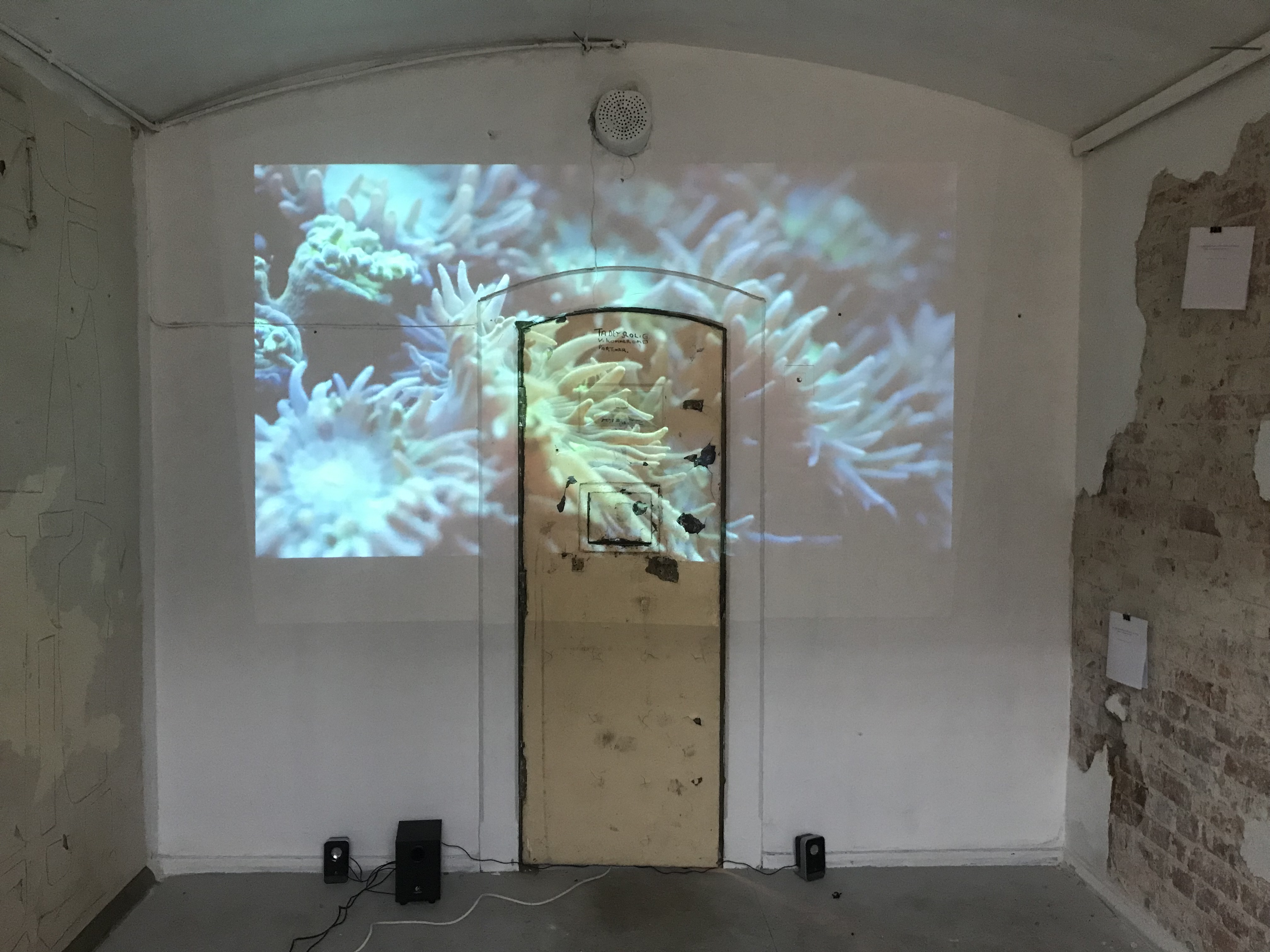The Coral Nation
The Coral Nation is an installation piece combining speech, audio and video in which the mysterious cold-water corals are advocating for their right to life as an imagined political entity.

Lophelia Pertusa, the most prolific species
of cold-water coral on the planet
Type of project:
Installation, Interdisciplenary, Explorations in Ocean Space
Year completed:
2021
Location:
Røst, Norwegian Coast,
67°24'59.4"N 9°58'02.3"E
Tutors:
Nancy Couling, Vibeke Jensen, Marianna Anichini
About a quarter of all marine life is directly dependent on the shelter offered by coral reefs across the globe. Without them much of the ocean’s ecosystems would collapse, resulting in widespread hunger among humans and animals living in coastal regions, especially in the Global South. Yet, rising temperatures, overfishing and acidification of the oceans are eradicating corals at unprecedented scales - consequences of humanity’s thoughtless over-exploitation of the planet’s resources
Installation, Interdisciplenary, Explorations in Ocean Space
Year completed:
2021
Location:
Røst, Norwegian Coast,
67°24'59.4"N 9°58'02.3"E
Tutors:
Nancy Couling, Vibeke Jensen, Marianna Anichini
About a quarter of all marine life is directly dependent on the shelter offered by coral reefs across the globe. Without them much of the ocean’s ecosystems would collapse, resulting in widespread hunger among humans and animals living in coastal regions, especially in the Global South. Yet, rising temperatures, overfishing and acidification of the oceans are eradicating corals at unprecedented scales - consequences of humanity’s thoughtless over-exploitation of the planet’s resources
Cold-water corals are largely unknown, yet incredibly important to the ocean’s ecosystems. They differ from the famous tropical corals in the way that they’re able to survive without sunlight and symbiotic relationships to photosynthesizing algae, because there simply isn’t any sunlight at their depths.
Despite this they form colonies of stony structures that are home to many small marine animals like small fish, larvae, sponges, crustaceans and the like. About 25% of all marine life depend on corals to survive, but fishing practices like bottom trawling, overfishing, deep sea mining, ocean acidification and rising temperatures are destroying coral reefs globally at unprecedented rates.
At depths of 200-2000+ meters below the ocean’s surface, where sunlight never reaches, they’re hard to access by diving and difficult to research. Thus most people don’t know they exist, even though Norwegian waters contain the largest cold-water coral reef on the planet: the Røst Reef.
Despite this they form colonies of stony structures that are home to many small marine animals like small fish, larvae, sponges, crustaceans and the like. About 25% of all marine life depend on corals to survive, but fishing practices like bottom trawling, overfishing, deep sea mining, ocean acidification and rising temperatures are destroying coral reefs globally at unprecedented rates.
At depths of 200-2000+ meters below the ocean’s surface, where sunlight never reaches, they’re hard to access by diving and difficult to research. Thus most people don’t know they exist, even though Norwegian waters contain the largest cold-water coral reef on the planet: the Røst Reef.



The Røst Reef. Photo by Mareano
At depths of 200-2000+ meters below the ocean’s surface, where sunlight never reaches, they’re hard to access by diving and difficult to research. Thus most people don’t know they exist, even though Norwegian waters contain the largest cold-water coral reef on the planet: the Røst Reef.
Its incredible scale, its age, its importance, its infinite complexity, and shroud of mystery fascinates all who explore it, but the fact that hardly anyone knows about it is frightening, because that’s how humanity will end up destroying it.
With the support of oceanographers and marine biologists a deep understanding of the role of cold-water corals in the ocean’s ecosystems were explored through spatial analyses, artistic documentation, scientific articles and modelmaking, leading to the installation piece “The Coral Nation”.
The work is part of Explorations in Ocean Space: an interdisciplinary, award winning, research-based master course at the Bergen School of Architecture.
With the support of oceanographers and marine biologists a deep understanding of the role of cold-water corals in the ocean’s ecosystems were explored through spatial analyses, artistic documentation, scientific articles and modelmaking, leading to the installation piece “The Coral Nation”.
The work is part of Explorations in Ocean Space: an interdisciplinary, award winning, research-based master course at the Bergen School of Architecture.



Mapping of oil rigs, stony corals, and damage to the sea bottom floor by bottom trawling



The mid-term group exhibition that later evolved into “Coastal Interference” - exhibited at 2022 Lisbon Triennale


Exploring spatial qualities of corals in model form.
Interesting, but not truly coral-like. A much appreciated dead end
Interesting, but not truly coral-like. A much appreciated dead end


I wanted to instil in the visitor the same feeling of awe for the corals that I have gained myself throughout my research and exploration, and hopefully give them a sense of ownership as well.
Humans are notoriously bad at understanding the non-human, so I made corals more relatable by imagining all the world’s corals coming together to form a new political entity – the Coral Nation – to negotiate their increasingly desperate situation.
The piece mimics the pavillions at the Venice Biennale and was exhibited in the disused Old Bergen Prison. A fitting venue, considering the topic
Humans are notoriously bad at understanding the non-human, so I made corals more relatable by imagining all the world’s corals coming together to form a new political entity – the Coral Nation – to negotiate their increasingly desperate situation.
The piece mimics the pavillions at the Venice Biennale and was exhibited in the disused Old Bergen Prison. A fitting venue, considering the topic
The piece consists of three elements: audio of a speech made to the United Nations General Assembly by a representative from the Coral Nation paired with video footage of dying coral reefs projected upon a wall, a booklet comparing coral reefs to human megacities, and samples of the cold-water coral Lophelia Pertusa suspended from another wall.
This anthropomorphization is morally tricky, as it gives a voice to the voiceless, but also makes assumptions of what the corals want. Therefore, the speech is presented in three different ways, held in succession as their situation worsens, their desperation increases and their time is about to run out...
Speeches:
The United Nations
Fire in the Streets
The end of the Ocean
Booklet
This anthropomorphization is morally tricky, as it gives a voice to the voiceless, but also makes assumptions of what the corals want. Therefore, the speech is presented in three different ways, held in succession as their situation worsens, their desperation increases and their time is about to run out...
Speeches:
The United Nations
Fire in the Streets
The end of the Ocean
Booklet



A year later the Coral Nation was included in the collective work: “Coastal Interference”, and was submitted to the 2022 Lisbon Triennale. It was accepted, exhibited, and won the prize for best student work in the “Master” category.